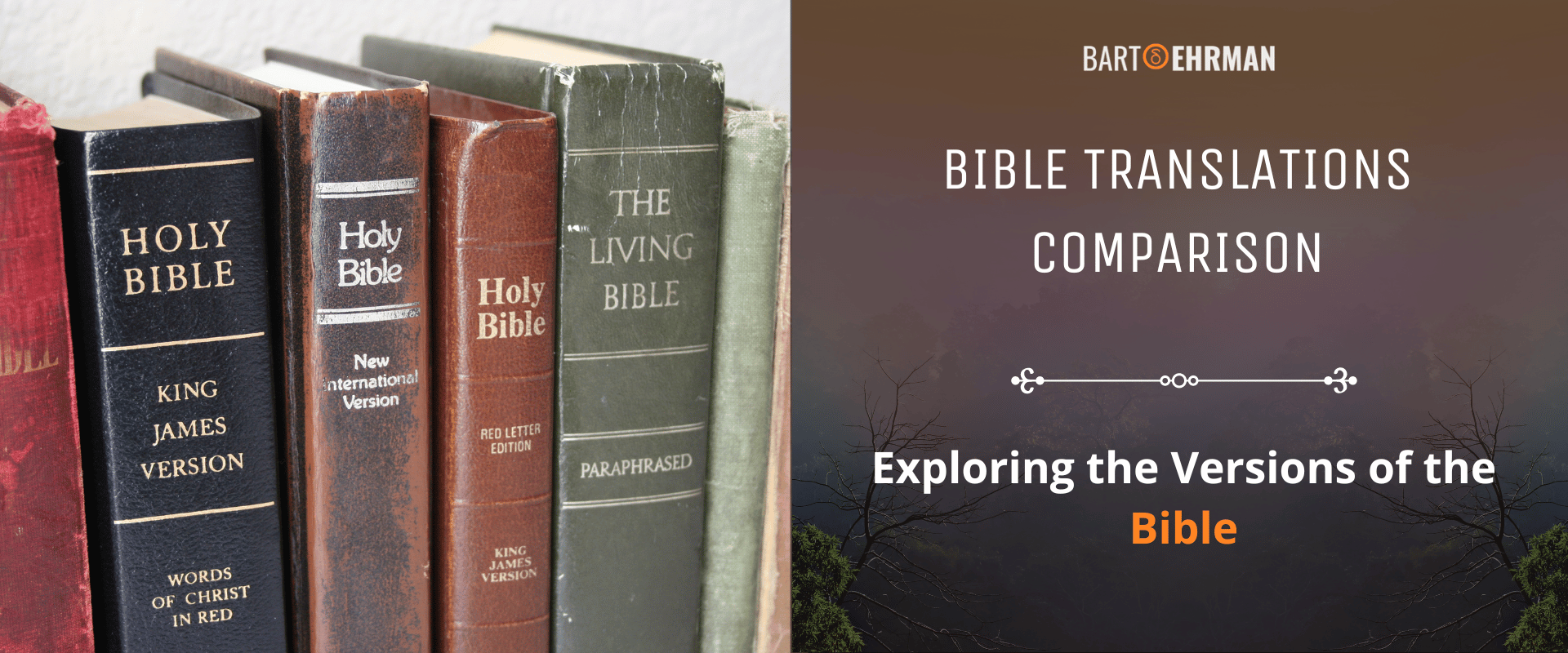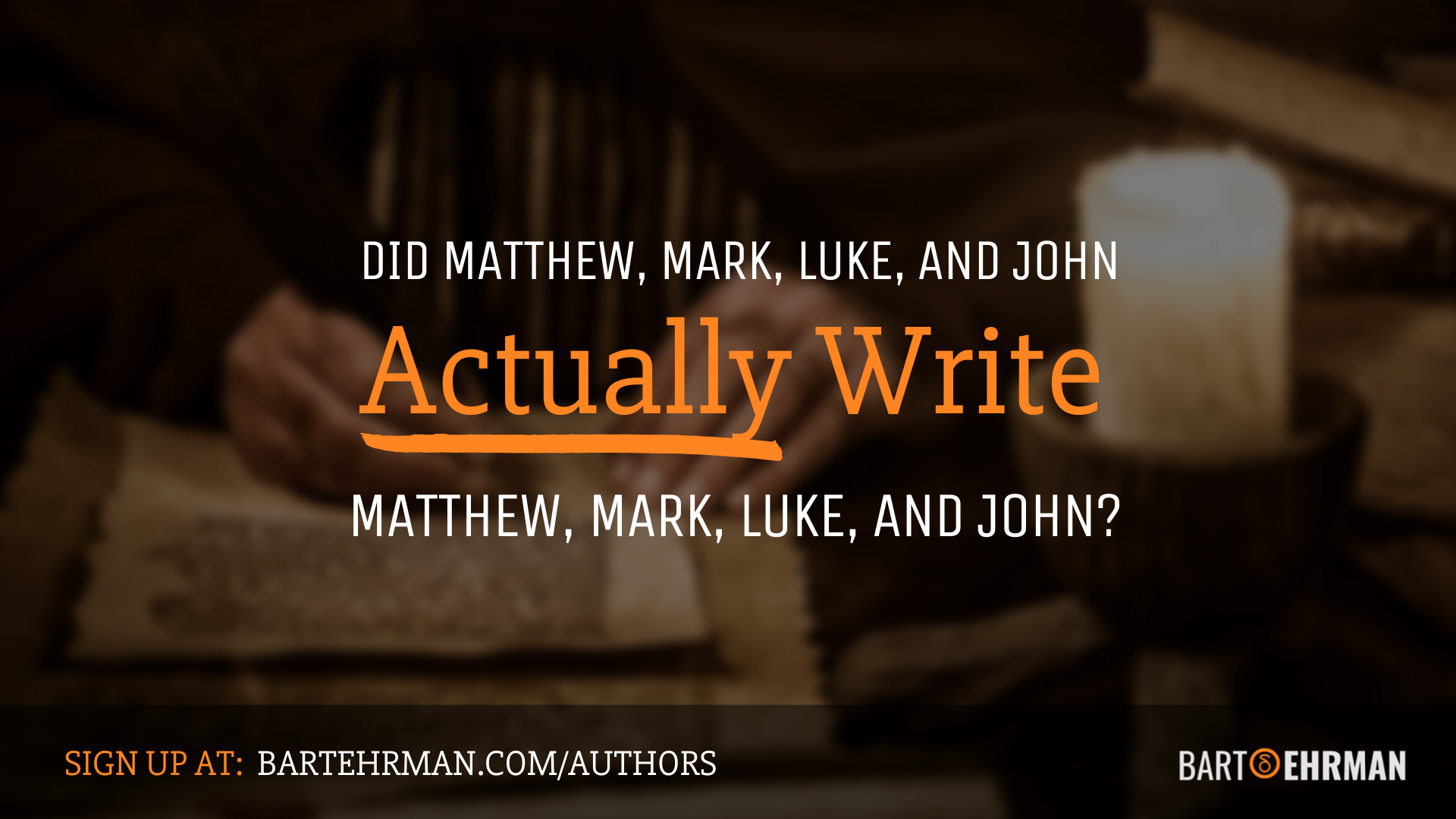Bible Translations Comparison: Exploring the Versions of the Bible

Written by Joshua Schachterle, Ph.D
Author | Professor | Scholar
Author | Professor | BE Contributor
Verified! See our editorial guidelines
Verified! See our guidelines
Edited by Laura Robinson, Ph.D.
Date written: February 20th, 2024
Disclaimer: The views and opinions expressed in this article belong to the author and do not necessarily match my own. - Dr. Bart D. Ehrman
There have been so many translations of the Bible that it’s difficult to keep track of them all. In fact, since the 16th century, there have been around 900 translations into English alone! How were these translations made and by whom? How do we know which versions are most accurate?
It’s often said that translation is interpretation. Indeed, it’s all but impossible to make a perfect one-to-one translation of any document without affecting the meaning. In this article, I’ll look at the history of English Bible translations, the sources they used, and some basic information about the most widely-used English Bible translations today.
"My favorite English Bible translation is the NRSV-Updated Edition (this is the latest updated version of the New Revised Standard Version) because it was made by scholars from different Christian traditions and is endorsed by well-known biblical scholars like Bart Ehrman. The latest version of it is called the *SBL Study Bible (SBL is the Society of Biblical Literature) and I highly recommend it. "
*Affiliate Disclaimer: We may earn commissions on products you purchase through this page at no additional cost to you. Thank you for supporting our site!

What Are Some Issues with Translating the Bible?
Consider the rather archaic English euphemism “He kicked the bucket”.
Native English speakers of a certain age will know that this phrase means “He died”. A non-native speaker of English, however, might understand the literal meaning – someone kicked a container called a bucket – but wouldn’t get the figurative meaning.
So what should translators do with such a phrase? Should they merely translate the words exactly as they are? That wouldn’t convey the intended meaning that someone died. Should they focus instead on the basic meaning and just say “He died”? That wouldn’t convey the folksy nature of the phrase. It’s complicated.
Timothy Beal gives some great examples of translation problems like this from the Hebrew Bible. In Exodus 32:10, when God becomes angry at the Israelites for worshiping a golden calf, most English translations have him say something like this to Moses:
Now let me alone so that my wrath may burn hot against them and I may consume them, and of you I will make a great nation.
However, if we were to translate the Hebrew literally, God says this:
Now let me alone so that my nose may burn hot against them and I may consume them, and of you I will make a great nation.
The English word “wrath” does convey the general meaning accurately: God is furious. However, it isn’t literally what the original Hebrew says. It says that his nose burns hot, a common ancient Hebrew euphemism for anger. Should translators go with the intended meaning or just translate the actual words?
In another example, the future king David encounters an ill-tempered man named Nabal who refuses to give him and his men supplies. Fortunately, Nabal’s wife Abigail sneaks some food to David and his men. 1 Samuel 25:34 quotes David as saying that if she had not done this:
truly by morning there would not have been left to Nabal so much as one male.
In other words, David would have killed all the males in Nabal’s family. However, a literal translation from the Hebrew would say this:
truly by morning there would not have been left to Nabal so much as one who pisses against a wall.
The general meaning is certainly conveyed by using the word “males”. But technically, that’s not what it says. Translators of any document have to make this kind of decision all the time.
The other translation issue involves sources.
What Sources Do Translators of the Bible Use?
We know that the Hebrew Bible/Old Testament was written in Hebrew (with a bit in Aramaic) and that the New Testament was written in Greek. So where do translators get these original writings from which they make their translations? It’s complicated. Really complicated.
First, the bad news: there are no extant autographs – or original writings – of any biblical text. What we have are copies of copies of copies of copies, ad infinitum.
In addition, the oldest biblical manuscripts are not complete Bibles as we know them today, but only parts of the Bible. Sometimes this means an entire book, while in other cases, all we have are fragments of a book.
This brings up an important question for a book considered divinely inspired by so many: If we don’t have the original(s), how do we know for certain what the original said?
Short answer: we don’t!
Scholars and translators gather as much manuscript evidence as they can for each book. While there are many, many variations between manuscripts, scholars do their best to approximate what was likely the original text based on a broad survey of all the manuscripts available.
The general standard for decent Bible translations today is to use what is known as the Masoretic Text for the Hebrew Bible and the Nestle–Aland edition (also called the Novum Testamentum Graece) for the New Testament. Both the Masoretic Text and the Nestle-Aland are compilations from different manuscripts. The best translations use other manuscript evidence as well, such as fragments of the Hebrew Bible from the Dead Sea Scrolls.
Having outlined in a very basic way some translation issues, let’s look briefly at the history of English Bible translations.
Earliest Translations of the Bible into English
While there were no complete English Bible translations from the Old English period (450-1150 CE), parts of the Bible were translated separately. This includes the Lindisfarne Gospels, made in the 10th century by a monastic scribe named Aldred, and a translation of much of the Hebrew Bible in the 11th century by an abbot named Ælfric.
The first complete English translation of the Bible was made in 1382 during the Middle English period (1066-1500 CE). It was credited to John Wycliffe, a Catholic priest and theologian, although most scholars believe he had significant uncredited help.
There were two different versions of Wycliffe’s translation, both made from the Latin version of the Bible known as the Vulgate. The first version sticks pretty rigidly to Latin word order. The second used the more common English word order of the time to make it more comprehensible to lay readers.
In the 1526, William Tyndale, a biblical scholar and linguist, made a modern English translation of the New Testament. He was the first English Bible translator to make use of the newly-invented printing press to copy his translation. The first complete modern English translation of the entire Bible was made by Miles Coverdale in 1535.
In 1604, King James I of England commissioned a new English translation of the Bible, which was completed by a team of translators in 1611. This became the standard English Bible until the last years of the 19th century, when new English translations began to proliferate.
Comparison of English Bible Versions
Take a look at the chart below. It will give you basic information about seven widely-known English Bible versions which I’ll expand upon below. Most versions are tied to certain Christian denominations.
By the way, Bible Gateway is a free online source for a lot of different versions of the Bible.
Bible | Date | Sources | Best Available |
|---|---|---|---|
King James Version (KJV) | 1611, 1679 | Masoretic Text, Textus Receptus, Tyndale New Testament, Erasmus Manuscripts. | The King James Study Bible by Thomas Nelson |
New International Version (NIV) | 1978, 1984, 2011 | Masoretic Text, Nestle-Aland Text | NIV Study Bible by Zondervan |
New American Standard Bible (NASB) | 1971, 1995, 2020 | Masoretic Text, Nestle-Aland Text | The NASB MacArthur Study Bible |
New Revised Standard Version | 1989, major update in 2021 | Masoretic Text, Nestle-Aland Text, plus many more (see below). | The SBL Study Bible |
English Standard Version | 2001, 2007, 2011, 2016 | From 1971 Revised Standard Version, Biblia Hebraica Stuttgartensia, UBS Greek New Testament, Nestle-Aland Text | ESV Study Bible - Winner of ECPA Book of the Year |
Christian Standard Bible (CSB) | 2017 | Biblia Hebraica Stuttgartensia, UBS Greek New Testament | CSB Everyday Study Bible by Holman |
The Living Bible | 1971 | This is a paraphrase of the American Standard Version | NLT Life Application Study Bible |
Earlier in the article, I gave The SBL Study Bible a 5-star rating, which is my own. In the table above, we've used the Amazon ratings for each recommendation.
King James Version
Completed in 1611, it was considered the official English Bible for almost 200 years. Some conservative Christian denominations still insist on using this translation, believing it to be the most authoritative version in English. In fact, there has been a “King James Only” movement in some churches ever since different English versions became available.
Its language is tied to the period in which it was written. Some find this language elegant and reverent while others just find it hard to understand.
There are many study Bibles available for the King James Version as well. The best rated on Amazon, however, is "The King James Study Bible" by Thomas Nelson which you can purchase as this link.
New International Version
In the 1950s, Howard Long, a businessman from Seattle, Washington decided that there should be a new version of the Bible using contemporary language as an alternative to the KJV. As a conservative evangelical Christian, he viewed the KJV language as an obstacle to his efforts at proselytizing.
He belonged to the Christian Reformed Church, a conservative Calvinist denomination, who formed a committee of 100 scholars to translate the Bible into more contemporary language. The first edition was produced in 1978. It remains one of the most popular English versions.
Note that Zondervan has an NIV Study Bible available on Amazon that has an incredible 4.8 star rating.
New American Standard Bible
This translation was funded by the Lockman Foundation, closely associated with the fundamentalist Southern Baptist Convention. Because all translation is interpretation, it’s important to keep this background in mind when reading this translation, especially when reading translator’s notes which might indicate certain interpretations in order to fit with the Lockman Foundations’ values.
New Revised Standard Version
This is considered the gold standard of English Bible translations for Bible scholars. Any time I’m writing an article in which I quote Bible verses, this is the translation I use. There was an extensive update in 2021, called the New Revised Standard Version Updated Edition (NRSVue) which you can find on Amazon below.
NRSV is also the version that Bart Ehrman prefers along with an annotated edition such as the Harper Collins Study Bible. Fun fact: Bart was invited to be a secretarial assistant for the committee producing the NRSV in the early 1980s. To read about what Bart did for the committee over the years, what the translation entailed, and what problems it had to confront, see the series on his blog beginning with “Metzger and Me. The NRSV Bible Translation Committee.” (Note, you must be a blog member to read the full article.)
The initial version of the NRSV was funded by the National Council of Churches, which included many Protestant, Catholic, and Orthodox churches, meant to ensure that there was a broad ecumenical level of consent about the translation. It also includes the Apocrypha.
If you’re interested in the academic study of the Bible, the NRSVue is your best bet.
English Standard Version
This version was first published in 2001 by Crossway, an evangelical Christian publisher. Accordingly, all the scholars who participated were evangelical Christians. As with several other Bible versions, this simply means that when there was doubt as to the meaning of the text, the translators made sure that their interpretation adhered to evangelical beliefs.
While it uses Greek and Hebrew sources, it also uses the original Revised Standard Version as a source, an odd choice if one is trying to get to the original text.
Christian Standard Bible
This version is published by Lifeway Christian Resources, the publishing division of the conservative Southern Baptist Convention. It is a revision of the 2009 edition of the Holman Christian Standard Bible (HCSB).
While Lifeway’s website says the HCSB was translated by a team of 100 scholars from 17 denominations, it also says the revision which resulted in the Christian Standard Bible was done by 21 conservative evangelical scholars.
The Living Bible
I wanted to include this version because it’s different from the others in one important way: it is a paraphrase of another English version, not a translation.
The Living Bible came out in 1971 and was made by Kenneth Taylor who also founded Tyndale House, a conservative evangelical publishing company. Taylor said that his children were having a hard time understanding the KJV and the American Standard Bible during their family devotions so he started paraphrasing it for them.
Taylor based his paraphrase on the American Standard Bible, a translation made in 1901. Ultimately, with the endorsement of mega-preacher Billy Graham and others, the Living Bible became a huge seller on the Bible market.
The New Living Translation (NLT), first published in 1996, is a revision of the Living Bible.

Side-By-Side Comparison of Philippians 2:5-7
Below is a chart comparing all seven of the versions I highlighted on the same three verses. Note that the differences can be consequential. For example, while the KJV has retained the original Greek idea of “Let this mind be in you,” the NIV adds “In your relationships with one another,” something not found in any Greek text.
The Living Bible changes the Greek of “emptied himself,” which several of these versions use, to “laid aside his mighty power and glory,” which is not found in the Greek text. These differences often show how certain denominations mold the text to fit their theologies.
King James Version | New International Version | New American Standard Bible | New Revised Standard Version (updated) |
|---|---|---|---|
5 Let this mind be in you, which was also in Christ Jesus: | 5 In your relationships with one another, have the same mindset as Christ Jesus:
| 5 Have this attitude in yourselves which was also in Christ Jesus, | 5 Let the same mind be in you that was in Christ Jesus,
|
English Standard Version | Christian Standard Bible | The Living Bible |
|---|---|---|
5 Have this mind among yourselves, which is yours in Christ Jesus, | 5 Adopt the same attitude as that of Christ Jesus,
| 5 Your attitude should be the kind that was shown us by Jesus Christ, |
Conclusion
Translating anything is difficult. It is extremely difficult to translate from one language to another without losing or changing the original meaning of the text. This is equally true of the Bible, of course, but with this text, the stakes are high. Many view the Bible as the Word of God, which creates a quandary when we see how many versions of the Bible exist in English alone.
One of the first problems is deciding when to translate literally and when to focus instead on the general meaning. Slang phrases and euphemisms are only two of the many examples where translators have to decide the best way to convey what the text says.
In addition, there is the problem of sources. We don’t have a single original copy of any biblical text. In many cases, our earliest manuscript of a text is a copy made centuries after the original. Translators have to take many manuscripts, whole texts but also fragments, and try to piece together what the original probably said.
The first complete English Bible was translated into (Middle) English in 1382. The King James Bible was completed in 1611 and was the standard until the 1880s when more modern translations were produced. This has led to a huge number of different English translations, often funded by certain denominations whose theologies affect the translation.
FREE COURSE!
WHY I AM NOT A CHRISTIAN
Raw, honest, and enlightening. Bart's story of why he deconverted from the Christian faith.
Over 6,000 enrolled!

